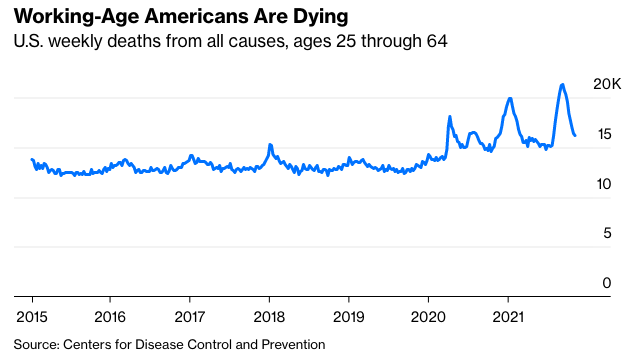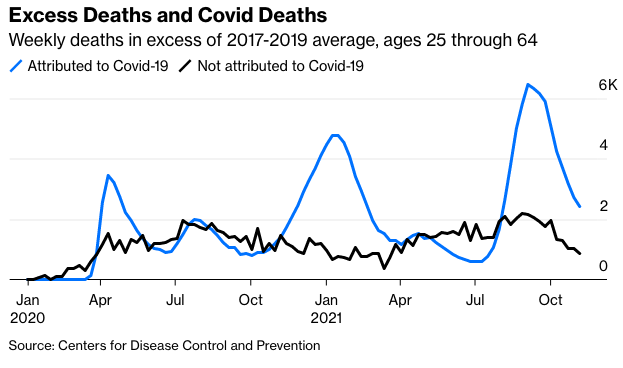Deaths among working-age Americans were up more than 40% over the pre-pandemic norm last summer and fall, the chief executive officer of an Indiana-based insurance company said late last month. His assertion has been reverberating around social media since, inspiring a much-shared Twitter thread that attributed it to vaccine side-effects until its author (to his credit) realized he’d misunderstood the data and deleted the whole thing, and a much-mocked tweet by Republican U.S. Rep. Jim Banks that “This is a catastrophe and we need to figure out why it’s happening.”
What’s happening is, mainly, a pandemic—the toll of which is not being fully reflected in Covid-19 death numbers, as OneAmerica Financial Partners CEO J. Scott Davison explained in a Dec. 30 video news conference (it’s all on YouTube) organized by the Indiana Chamber of Commerce. “The pandemic-related deaths are much larger than what you’re seeing in the news as the official specific Covid deaths, where Covid was the proximate cause of death on the death certificate,” said Davison, who has been observing the phenomenon through the lens of his company’s life insurance business. “What we’re seeing is that people get Covid, they kind of recover, and then they die from some sort of disease mechanism that was impacted by the fact that they got Covid in the first place.”
That the pandemic’s true toll in the U.S. is probably higher than the official Covid death numbers is one of those things that virtually everyone familiar with the mortality statistics agrees on. But it tends to get lost in public discussion because so much attention is paid to the role played by underlying conditions such as heart disease, diabetes and Alzheimer’s disease—as well as the occasional case where someone with Covid who dies of a gunshot wound gets added to the informal Covid death toll, only to be removed later. In the final tally of 2020 U.S. deaths released last month, which is based on what physicians, medical examiners and coroners put on death certificates, the Centers for Disease Control and Prevention counted 350,831 with Covid-19 as the underlying cause and another 33,705 with it as a contributing cause. But there were also 65,205 more deaths from heart disease, diabetes and Alzheimer’s in 2020 than 2019, and while 14,161 such deaths listed Covid as a contributing cause, it seems likely that much of the rest of the increase was Covid-related too.
Some were related to the pandemic even if they didn’t involve catching Covid. “This would be cases where people perhaps didn’t get the care that they needed for whatever reason,” CDC mortality statistics chief Robert Anderson explained, “either they were afraid to go to the hospital or the doctor or they weren’t able to get into the doctor.” There were also big increases in homicides and drug overdoses in 2020 that appear to have been sustained in 2021, and there was a sharp rise in traffic fatalities in the first half of 2021. Early in the pandemic, pre-emptive lockdowns could plausibly be blamed for this collateral damage, but since the summer of 2020 it seems to have been mainly the pandemic itself sparking the behavior changes that have led to higher mortality rates.
There were some ominous pre-existing trends too, with concern about them leading the National Academies of Science, Engineering and Medicine to appoint a Committee on High and Rising Midlife Mortality Rates and Socioeconomic Disparities in 2019 (its report came out last year). But while working-age mortality rates were rising before March 2020, they were doing so pretty slowly. Since then it’s been an explosion, with last summer and early fall the deadliest yet.

Mortality statistics arrive at the CDC from state and local health departments with variable and sometimes quite long lags, which is why I’ve cut my charts here off at the week ending November 6 even though there are numbers available from more recent weeks. Even the final few weeks represented above are probably incomplete.
Compare these all-causes deaths totals to the CDC’s provisional Covid-19 death statistics, and there are some interesting patterns. (Just to clarify what I did here, I calculated weekly deaths averages for 2017 through 2019, subtracted them from the deaths in equivalent weeks in 2020 and 2021, then split any excess between deaths that the CDC attributed to Covid and deaths that it did not.)

The sharp rise in excess deaths not attributed to Covid-19 very early in the pandemic can, I think, be pretty easily explained by the dearth of Covid testing at the time. Those were simply unreported Covid deaths. Since then, a seasonal pattern has set in in which excess deaths not attributed to Covid rise in the summer and fall in the winter. Homicides and traffic fatalities tend to rise in the summer and fall in the winter too, so that’s surely part of it. Another possibility is that the summer/early-fall Covid surges have been concentrated in places—the South in particular and rural areas in general—where there may be social and political pressures pushing doctors and local authorities away from attributing deaths to Covid, while winter surges have been worst in places where the pressures likely run in the opposite direction.








